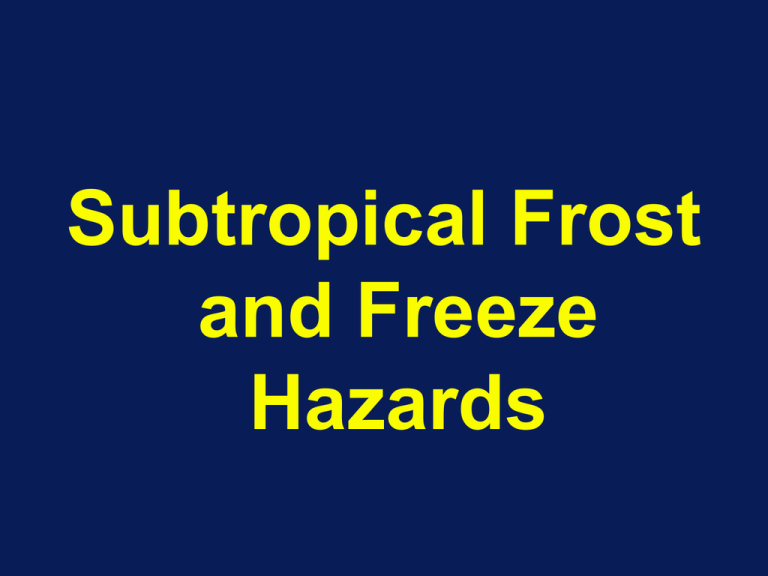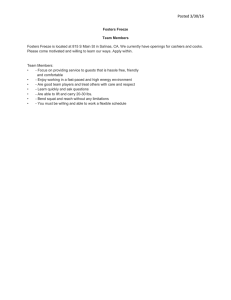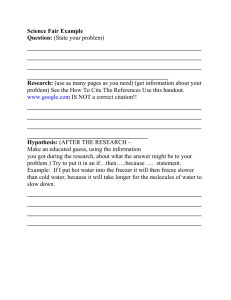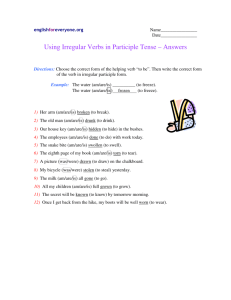Subtropical Frost and Freeze Hazards
advertisement

Subtropical Frost and Freeze Hazards Freeze Damage in Citrus Trunk Leaf damage Fruit damage Freeze damage on citrus production Complete lost of citrus groves Frost Hazards • Ranks with pest control, nutrition, and irrigation. • May be most limiting factor –1962-63 entire Northern Hemi. –Texas from 10 M boxes in 1961 to 740,000 boxes in 1964. Wind Machines • Only for frosts • Most effective in hill and valley topography - California • Mixes inversion layers (upper warmer air with lower colder air) • Increase temp 0.5 to 1.5o C • One machine / 5 to 8 acres Damage Continues • Frost and Freeze losses in winter of 1983-84. Loss of 100,000 Ha. • Brazil seldom has loss from frosts and freezes. • Mediterranean area protected by Alps (Oriented east - west). • Rockies are North - South. Frost or Freeze? • Frost - Wind is light to none (Radiation) • Freeze - Wind over 10 mph (advective). • Since damage occurs by ice formation - term freeze hardiness fits what happens in fruit. Freeze Avoidance (Supercooling) • Citrus species supercool threshold: –Fruit - 5o C –Mature leaves - - 7o C –Stems - 8.9o C –Non-acclimated < - 2o C –Flower -4.3oC Intercellular Ice Formation • Citrus tolerates some ice formation between cells. –Watersoaking at - 3o C may not cause leaf abscission. Freeze Acclimation • Function of –Soil temperature –Tissue temperature –Day length º Better under long days –Increased metabolites Freeze Tolerance • Is defined as the ability of plants to survive ice formation in extracellular tissues without significant damage to membrane or other cell components (Thomashow, 1993). – decrease of water potential in tissues due to sugar accumulation in vacuoles. – a significant increase in the abscisic acid levels which result in modification of protein synthesis. • The process of adaptation to low temperatures may cause changes in the function of genes and proteins. Tolerance of freeze damage • Citron < limes & lemons < grapefruit & pummelo < sweet oranges < tangerines & hybrids < sour orange < satsuma < kumquats < cintranges < Trifoliate orange. Maximum Acclimation • Daytime temps/ 20 to 25o C • Night- time air & soil temp/ less than 12o C for 2 weeks or more. • Causes quiescence (not dormancy). • Loss of hardiness > 12.5o C. Biochemical Changes • Sugar content increases with acclimation. • Lowers freezing point and acts as a cryoprotectant for cell membranes. • Critical are minimum temp. and duration below minimum. Passive Protection Methods • Site selection –Weather Records –Avoid low places (Frosts) –Wind breaks N & NW (Freezes) º Trees º Shade cloth. More Passive Methods • Clean cultivated, packed soil absorbs more net radiation from sun, thus more radiant energy at night than sod covered or newly cultivated orchard floor. • Orangeries- since Roman times. • Tree cover-Today near Sorrento, Italy. • Tree wraps Still More Passive Methods • Japanese grow citrus in greenhouses –Frost protection –Hastens fruit maturity • Taiwanese grow peaches under cover. (prevents frost & leaf curl) Active Methods - University Return Stack Heating • Protection against both frosts and freezes. – Initial $40 x 48 = $1920/A –Annual operating 5 gal diesel x $0.65 x 48 x 4 nights + $50 labor = $674 –Total = $2594/A first year Return Stack Specifications • • • • • • Best of oil heaters One hole setting uses 0.3 gph Three hole setting uses 1 gph 30,000 BTU / hr (20 - 70% radiant) Energy directed horizontally Rain in stack - blow over Other Heaters • Large Cone - slightly more radiant energy less blow over • Short Stack Heater - Smoke • Open Pots - Don’t even think about it. FREEZE PROTECTION METHODS Heaters Soil banking Pressurized Oil Systems • Diesel delivered though underground plastic tubes • Efficient • Must keep nozzles cool • Problems - high pressure oil, filter clogging Propane Heaters Vapor Pressure of propane • Temperature PSI – 70o F 109 – 32o F 54 – - 44o F 0 – 130oF 257 • 30,000 gal tank / 60 acre orchard Solid Fuel Blocks • Once cost effective - but not now • Four blocks under grapefruit canopy raised temp 13o F • Unique for LGRV –Fewer frosts / season –Store under trees all year Irrigation - Frost Protection • Provides Sensible Heat – Warm water source • Heat of Fusion • Only for frosts – Evaporative cooling removes 7.5 times as much energy from irrigated area than provided by Heat of Fusion. WRAPS Foam wrap Polyurethane wrap Fiber-glass wrap Overhead Irrigation • Heavy foliage accumulates ice which breaks limbs. • Works better on strawberries and blueberries. • Primarily used on citrus nurseries. Microsprinklers • At ground level elevates 1 to 2o C to lower canopy • No help for fruit and upper canopy • Elevated about 1 m give some protection of scaffold limbs quicker re-establishment. Elevated Microsprinklers • Excellent results 12.5 gph / tree • Hardie Microsprinkler III • Protected peach buds when air temp dropped to 18o F (- 8o C) • Rieger, Mark and S. C. Myers. 1990. HortScience 25:632-635. Microsprinkler Limitations • One 5HP pump for 5 A –Same pump irrigates 20 A • LRGV Irrigation Districts - water not available on demand. Insulators and Tree Wraps • Soil banks effective –Expensive but saves trunk. –Remove in spring. • Polyurethane foam wrap banded with metal strapping. • Plastic bag of water between wrap and trunk??? Sprinklers Overhead sprinklers Under tree micro-sprinkler Damage of citrus trees by sprinkler system THE END



